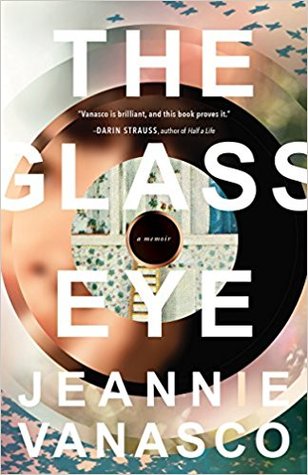Reviewed by Melissa Oliveira
 Towards the end of her debut memoir The Glass Eye (Tin House Books, October 2017), Jeannie Vanasco writes about a post-workshop conversation discussing an early draft of the manuscript. Her classmate urges her to do more scene-setting around the periods of psychosis and mania in the book. When Vanasco says that she doesn’t really remember much and expresses reservations about re-creating these scenes, the classmate cuts in: “‘The mental illness stuff,’ she said, ‘Is the most interesting. There definitely should be more scenes of you losing it.’”
Towards the end of her debut memoir The Glass Eye (Tin House Books, October 2017), Jeannie Vanasco writes about a post-workshop conversation discussing an early draft of the manuscript. Her classmate urges her to do more scene-setting around the periods of psychosis and mania in the book. When Vanasco says that she doesn’t really remember much and expresses reservations about re-creating these scenes, the classmate cuts in: “‘The mental illness stuff,’ she said, ‘Is the most interesting. There definitely should be more scenes of you losing it.’”
What struck me most about this statement was how it expresses a potential pitfall of writing a memoir that deals so candidly with issues of mental illness: that the memoirist might feel some pressure to play to type in order to satisfy a kind of voyeurism. The writer could simply make it more “interesting” by inventing a little more scenic detail here, ratcheting up the drama there and in doing so, I guess, edge quietly over into fiction.
What Vanasco does in her book is way more compelling than filling in what she doesn’t know: she experiments with form by shattering the story into shards of poetic prose. Throughout the piece, she provides a meta-narrative about the process of writing the memoir we are reading. The resulting book is not only beautiful and complex, but also a great example of what is possible when a very skilled storyteller starts manipulating form in a way that allows her to go deeper into the subject, in part by commenting openly on all the things she might not remember. We don’t need more dramatic scenes in which the memoirist loses it; we have a form that allows us to experience the mind — whether psychotic or lucid, spinning or still — at work.
And yet The Glass Eye isn’t solely a mental illness memoir; the book could also easily be categorized as a memoir about family, writing, or grief. It is also, interestingly, a gift: “The night before he died,” Vanasco writes, “I promised my dad I would write a book for him.” The figure of Vanasco’s father is rendered lovingly, allowing the reader to get a strong sense of this older, gentle man who is worried that his glass eye and gravelly voice would upset his little girl. Her father’s flaws come by way of a jealousy and overprotectiveness that could exert itself over his wife and daughter. The protective impulse over his daughter comes from his own grief after having lost a teenaged daughter in his previous marriage. The other daughter’s name was also Jeanne, pronounced the same way as the author’s but spelled without the I:“I tried not to hear her name when he said my own,” Vanasco writes, though she can’t resist the metaphor of this “sonic thesis” in her memoir. The other Jeanne seems to haunt both Vanasco’s childhood and this memoir, with the dead daughter’s goodness always ripe for comparison with Vanasco’s own behavior, imperfections, and a looming mental illness that finally overcomes her when her father dies.
Vanasco’s book itself represents about a decade worth of effort: of research, writing, and workshopping; of periods of calm punctuated by harrowing spirals into psychosis. The psychotic breaks appear to coincide with any sustained work on the book and result in a series of stays in psychiatric hospitals where “any behavior can become a symptom” — including writing. Vanasco finds labels, medicines, and diagnoses in these places, but not always relief from her mania. She insists repeatedly that her diagnosis is merely a powerful kind of grief and that writing helps soothe her, yet she is met with the suggestion that she try not writing for awhile. Mental illness and the writing process, we come to understand, resemble each other in certain ways.
So, how to render the experience of an unraveling mind in a way that doesn’t simply transform her into a helpless victim, a walking diagnosis, or a spectacle? Or, as Vanasco puts it, “How can I capture mania on the page and still make sense?” It’s a tricky thing, to be sure, but it is one that Vanasco pulls off by employing structural experimentation, shattering her narrative into short prose sections like “Dad,” “Mom,” “Jeanne,” and “Mental Illness.” She depends on sonic and associative connections to bring ideas together, to great effect.
Those who admire nonfiction about mental illness, family, and grief will likely enjoy this debut memoir; I was reminded of work by Lauren Slater and Kay Jamison, though this is a more novel approach to the subject. Lovers of experimental nonfiction and the lyric essay— those who, like me, happily devour work by Maggie Nelson, Lia Purpura, Eula Biss, and others — will likely love The Glass Eye for being an absorbing and totally inventive new work of nonfiction.


